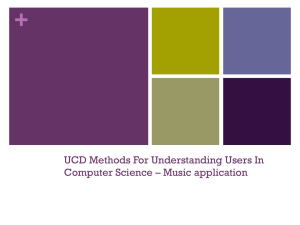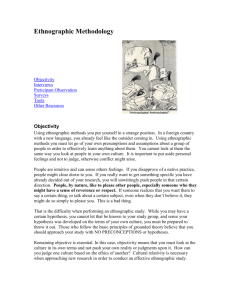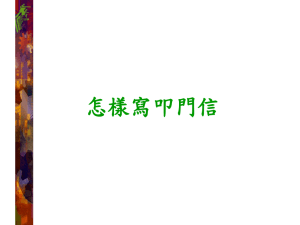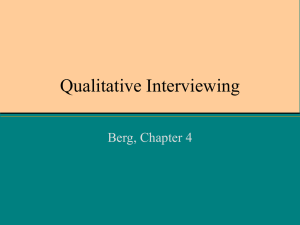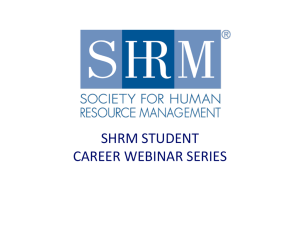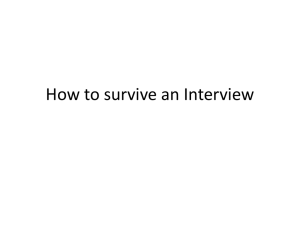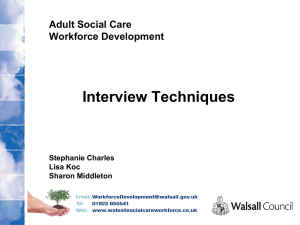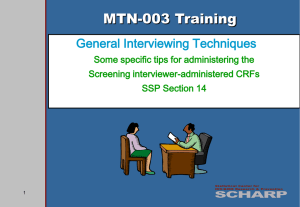FOCUS GROUPS & INTERVIEWS
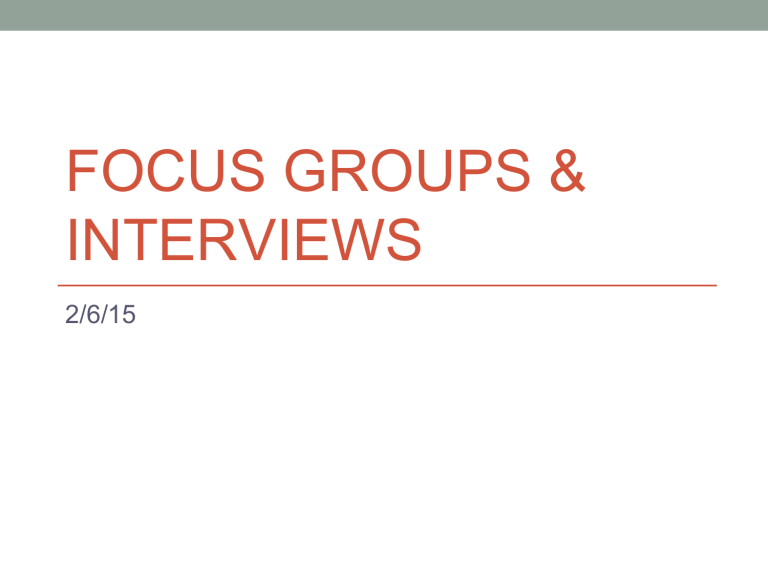
FOCUS GROUPS &
INTERVIEWS
2/6/15
Overview
• Interview types
• Designing interview questions
• Focus groups (Customer research)
• Overview of guidelines for project stage 2: Customer research
Interviews
• Unstructured
– Are not directed by a script – exploratory
– But… plan main topics to be covered
– Uses open questions
• e.g. What are the advantages of touchscreens?
– Pro: interviewees may mention issues interviewer hasn’t considered
– Cons: data heavy, not consistent across participants, time consuming and difficult to analyze
– Rich but not replicable
– Not appropriate for your purposes
Interviews
• Structured
• Are tightly scripted, often like a questionnaire
•
• Questions are short and clearly worded
Closed questions
• e.g. How often do you visit the HCI class website: everyday, once a week, once a month, less than once a month?
• Closed questions are good when range of possible answers is known
• Standardized across participants
•
• Worded exactly the same for each participant
Always asked in the same order
• Appropriate for your purposes
Interviews
• Semi-structured
• Combo of structured and unstructured
•
•
Guided by a script but interesting issues can be explored in more depth
Plan main topics – so same topics are covered with each participant
•
•
Start with open question followed by closed question
• OPEN: Tell me about the layout of the site < difficult to use>
• CLOSED: what would make it easier to use?
**Must be careful that the question phrasing doesn’t lead participant to a particular answer**
• e.g. You seemed to like the use of color
• Very appropriate for your purposes
Interview questions
• Two types:
− closed questions have a predetermined answer format, e.g., ‘yes’ or ‘no’, ‘everyday’ or ‘once a week’
− open questions do not have a predetermined format
• Closed questions are easier to analyze
Interview questions
•
• Guidelines for developing questions (Robson 2002)
Avoid:
• Long questions
• Compound sentences - split them into two
• e.g. How do you like this cell phone compared with previous ones you’ve had?
•
1.
How do you like this phone?
2.
Have you owned others?
3.
If so, how did you like it/them?
Easier for interviewee to respond and easier for interviewer to take notes
•
•
•
Jargon and language that the interviewee may not understand
Leading questions that make assumptions e.g., why do you like …?
• Assumes person does like it – can discourage reporting true feelings
Unconscious biases e.g., gender stereotypes
Running the interview
• Introduction
– Introduce yourself
– Clearly explain the goals of the interview
• e.g., the goal is to determine a set of user requirements for this application/interface
– Reassure about the ethical issues
– Ask for their permission to take notes
• Warm-up
– Make first questions easy and non-threatening
• e.g., What is your major? What year are you?
Running the interview
• Main body
– Present questions in a logical order
• A cool-off period
– Include a few easy questions to defuse tension at the end
• Closure
– Thank interviewee, signal the end, e.g, put notebooks away
Focus groups
• Normally 3 – 10 people
• Discussion / interview led by 1 person
• It’s the PM in your case
• Other team members must be present to take notes
• A preset agenda is used to guide the discussion
• Pros:
• Allows diverse issues to be raised that might otherwise be missed
• Individuals develop opinions by talking to others
• Cons:
• One person may dominate discussion
• Discourages others from speaking up
Enriching the interview process
• Props - devices for prompting interviewee, e.g., a prototype, scenario
Project 2: Customer research
• Develop your focus group/interview agenda
• Be sure to cover all the important points for procedure
• Main topics to cover during the focus group
• Determine clients’ impressions of the problem you are trying to address
•
•
Determine improvements the clients want
Determine clients’ solutions to the interface
Resources
• https://assessment.trinity.duke.edu/documents/How_t o_Conduct_a_Focus_Group.pdf
• 8 questions ideal
• A focus group is not:
• A debate
Group therapy
A conflict resolution session
A problem solving session
An opportunity to collaborate A promotional opportunity
An educational session
Role Play
• Groups of 4
• Choose the conductor
• Choose participant A
• Choose participant B
• Choose participant C
Participant A
The shy one: you don’t speak unless spoken to.
Participant B
The dominator: you are speak your opinions as fact
Participant C
The rambler: you talk a lot and jump in when others are talking
Question
Overall goal: UF has asked you to solve the problem: they want to have students eat more at campus restaurants for dinner
1.
(Open ended) Describe about your typical dinner plans for a week.
2.
(Open ended) Describe how you get to campus and around campus.
3.
(Close ended) On a scale of 1-5 where 5 is highest, how important is price to your dinner plans?
4.
(Close ended) On a scale of 1-5 where 5 is highest, how important is quality of food to your dinner plans?




